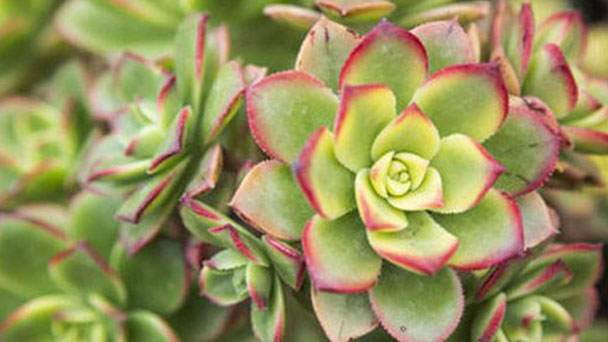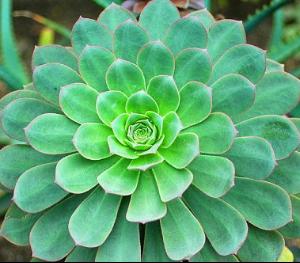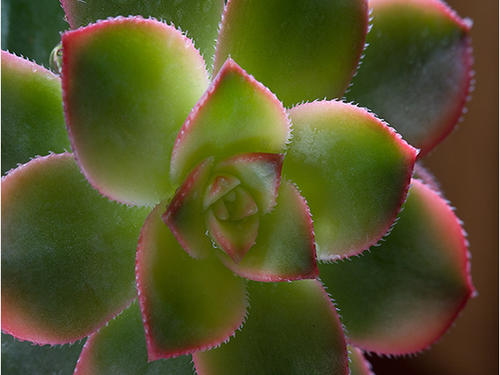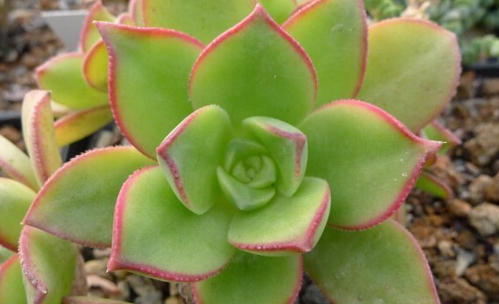Aeonium Haworthii Profile: Plant Info, Care & Growing Guide
Written by Maggie
Dec 06 2021

Aeonium Haworthii, also called Haworth's aeonium, is a sub-shrub, native to the Atlantic Canary Islands and Morocco and other places, introduced in our country. Aeonium Haworthii leaves are obovate, apiculate, 2.5 -- 5cm long, thick, bluish-green, glaucous, margin reddish brown. Cymes are with pale yellow, sometimes reddish flowers.
Aeonium Haworthii Picture

Characteristics of Aeonium Haworthii
Aeonium Haworthii is 25-50cm high, branch tip leaves arranged in a lotus shape. Leaves are obovate, apiculate, 2.5 -- 5cm long, thick, bluish-green, glaucous, margin reddish brown. Cymes with pale yellow, sometimes reddish flowers.
Aeonium Haworthii Growth Habits
Haworth's aeonium is a subshrub, the origin of dry hot summer with little rain, the average temperature of 25℃, mild and humid winter, the average temperature of 10℃, annual rainfall of 1000mm. aeonium haworthii prefers sunny sandy loam with good drainage.
Aeonium Haworthii Distribution
Aeonium Haworthii is originally produced in the Atlantic Canary Islands.
How to Grow & Care for Aeonium Haworthii
1. Planting Aeonium Haworthii
Plant Aeonium Haworthii before spring bud. In the southern region can be planted, overwintering on the ground. Aeonium Haworthii should be planted in the sunny, ventilated, well-drained land and loose, fertile sandy soil. Potted Aeonium Haworthii is suitable for indoor overwintering in northern areas. The basin soil selects the culture soil mixed with leaf rot soil, garden soil and coarse sand. The basin should not be too big, before planting a few broken tiles, broken bricks in the basin bottom pad, so that drainage. When the root system is crowded and affects watering, soil and pot should be changed in time. Generally 1-2 years for 1 basin soil. When changing soil by pot, part of the old roots of Aeonium Haworthii and too dense, too long roots should be thinned. After planting, pour 1 time of water, put it Aeonium Haworthii a shady place, and move to a sunny place to cultivate when the growth is restored.
2. Aeonium Haworthii Light & Temperature Requirements
The growing season of Haworth's aeonium should be placed in a sunny, well-ventilated place. Summer into hibernation, the requirement of half shade and well-ventilated environment, in high temperature should be shed shade or placed under the tree shade, can also be placed indoors, but should maintain good ventilation, the temperature is above 25℃. In winter, Aeonium Haworthii should be in the greenhouse or indoor sunny place, the room temperature should be kept above 10℃, the minimum temperature can not be lower than 5℃, the temperature is too low to do cold preventive measures.
3. Aeonium Haworthii Watering & Fertilizing
In spring and autumn Haworth's aeonium growing season, we should pay attention to watering, keep the basin soil wet and dry, can not water and wet. Summer into hibernation, especially in the high temperature and humidity environment, to maintain good ventilation conditions, control watering, so as not to cause fallen leaves and root rot. In winter to reduce watering, basin soil in order to keep slightly dry is appropriate.

How to Propagate Aeonium Haworthii
Propagation of Aeonium haworthii can be made by cutting rosette in early spring, and the remaining stems will produce tiller buds. A well-bred breed, if left unpruned, tends to grow tall and form more durable old stalks.
Disease Control of Aeonium Haworthii
Rustiness, leaf spot and root-knot nematodes of Haworth's aeonium may occur, which can be controlled with 75% chlorothalonil WP 800 times solution, and root-knot nematodes with 3% Carbofuran granules. Insect damage to black weevil, spray with 25% Sivetin WP 500 times liquid.
When growing Aeonium Haworthii, such as drought, poor ventilation, prone to red spider harm. After the occurrence, spraying 40% oxidized dimethoate emulsion agent 1000-2000 times liquid for prevention and control.
Latest Updated
- Benefits of Bugleweed - 7 Science-backed Health Benefits
- Bugleweed Dangers & Side Effects - Is It Poisonous?
- How to Plant Evergreen Trees - What You Should Know
- When to Plant Evergreens - Grow Guide for Evergreen Trees
- 12 Wonderful Evergreen Shrubs for Your Garden
- 12 Popular Evergreen Plants with Pictures for Beginners
- When And How To Prune A Lilac Bush Like a Pro
- How to Grow & Care for Lilac Vine (Hardenbergia Violacea)
- Japanese Lilac Tree (Syringa Reticulata) Care & Propagation Guide
- Shumard Oak Pros and Cons - What to Know
Popular Articles
- Winter maintenance of Antirrhinum Majus
- How to Grow Terminalia Mantaly Tree
- How to Grow and Care for Crossostephium Chinense
- How to grow Antirrhinum Majus in spring
- Peristeria Elata (Dove Orchid) Profile: Info & Care Guide
- Underwatered Snake Plant (Sansevieria Trifasciata) - Signs And How To Fix
- How to Care for Brazilian Jasmine Plant (Mandevilla Sanderi)
- How to Grow & Care for Graptopetalum Purple Delight in Summer
- Rosa Chinensis (China Rose): Plant Growing & Care Tips
- How to Care for Baby Sun Rose (Aptenia Cordifolia)